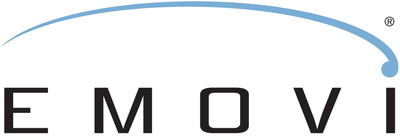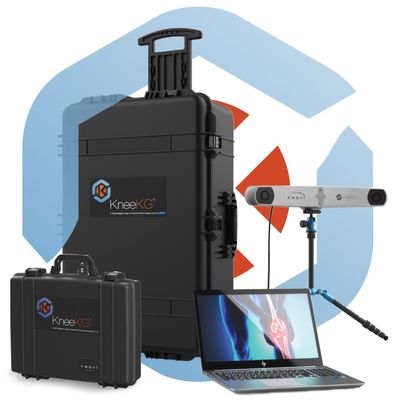


Emovi KneeKG - Knee Kinesiography System
Knee Kinesiography with the KneeKG® System offers a way to understand what is happening with the patient’s knee, in order to better identify causes of symptoms.
Knee anatomy is remarkable in its complexity.
Traditionally considered the body’s workhorse, the knee joint is prone to instabilities, injuries, and signature patterns that lead to common pathologies.
The KneeKG system is a portable, validated, FDA (510k) cleared, medical device capable of assessing knee motion, in 3D, for patients with impaired movement function of an orthopaedic cause, complementing the x-ray and MRI. This assessment, known as Knee Kinesiography, quickly provides accurate, reliable, and real-time data quantifying knee joint motion in all three planes under dynamic and loaded conditions.
The exam explicitly defines biomechanical dysfunctions, including any dynamic varus/valgus malalignment and thrust that may be associated with knee pain, instability, stress on the cartilage at loading and pathology-specific risk factors in osteoarthritis, patella-femoral syndromes, ACL and others.
This information can be used to improve patient’s satisfaction.
Knee Kinesiography is to the knee what an electrocardiogram (EKG) is to the heart.
The Knee Kinesiography examination with the KneeKG system has received strong recommendation from the AAOS Guidelines 2021 to provide targeted exercises and educate the patient in order to bring significant improvement of Symptoms, Pain Scores, Function during Activity of Daily Living, and Overall KOOS Score.
The test is done by a healthcare professional who has been trained by Emovi
The knee attachment system “exoskeleton”, designed to eliminate movement artifact of the skin and muscles, is placed on the patient’s lower limb. Using an optical system, 3D knee kinematics are captured during walking on a conventional treadmill at a self-determined comfortable speed, in a dynamic, weight-bearing context. Data are captured in all 3 planes of movement.
Indicated for the appropriate assessment of 3D knee motion for patients who have impared movement functions of an orthopaedic cause such as:
- Knee Osteoarthritis
- Ligaments, Meniscus
- Sports injuries
- Knee pain
This exam identifies and measures biomechanical deficit related to the progression and symptoms of various knee pathologies and/or trauma.
These injuries are identified from the raw KneeKG system measurements, which are the 3D kinematics of the knee and include:
- Flexion/Extension;
- Varus/Valgus;
- AP translation;
- Internal/External tibial rotation.
The KneeKG algorithms then analyze the datas automatically and identify evidence-based Mechanical Biomarkers. The KneeKG System is a clinical resource that generates immediate results in the form of written reports, which includes visual aids.
- Knee function
- The impact of an injury on the knee joint function;
- Mechanical biomarkers linked with the development and progression of knee pathologies;
- The impact of treatments/surgery on the knee joint function.
The results of a Knee Kinesiography with the KneeKG system enables the healthcare provider to rapidly:
- Gain an understanding of the root causes of a patient’s symptoms and how to manage the problem efficiently with objective data.
- Create a “patient specific” treatment plan which better enables achieving full, functional recovery, rather than simply treating the pain. Helping patients play an active role in management of their problem.
Do you have knee pain and would like to understand the exact cause of it? Have you already consulted a physician or healthcare professional, but the pain persists or the symptoms cause limitations in your activities? Have you tried treatment plans, but did not achieve the desired results of decreased or elimination of the pain? A Knee Kinesiography of your knee with the KneeKG System can provide you with a possible solution!
What Is Knee Kinesiography?
Knee Kinesiography with KneeKG, is a brief in-clinic exam that accurately and objectively assesses movement of the knee while the patient walks on a conventional treadmill. It is to the knee what the electrocardiogram (EKG) is to the heart – demonstrating exactly how the joint functions.
A KneeKG assessment allows you to identify the state of the knee’s mechanical function by capturing the active knee movement and enabling you to understand the deficits associated to your knee pain and other symptoms.
The following points clarify and emphasize the difference between radiography, MRI, and Knee Kinesiography:
- X-ray provides an image of the bones and is acquired while in a static (stationary) position
- MRI provides an image of the soft tissue and is acquired while in a static (stationary) position
- Knee Kinesiography analyzes the function (movements) of your knee and is conducted while in an ACTIVE, upright position
- It is not necessary to do an X-ray or an MRI before a Knee Kinesiography
- 42 % pain reduction after 6 months by addressing mechanical deficits identified with the KneeKG System1
- 88 % treatment adherence after 3 months1
- 84 % patient satisfaction when the KneeKG System is used across the continuum of care2
- 63 % of patients chose to delay surgery after 1 year3
- 80% of these patients had postponed surgery after 4 years3
- 24 % of patients not requiring surgery can be removed before entering the queue for the consultation of a surgeon5
HIGH PRECISION to confirm appropriateness for surgery4


